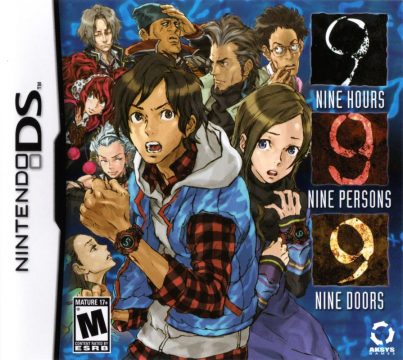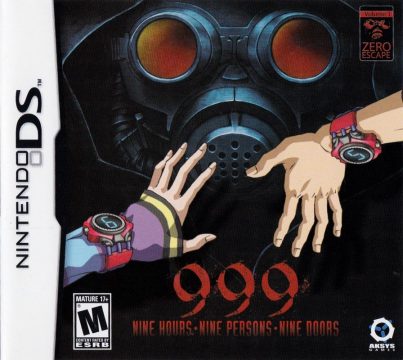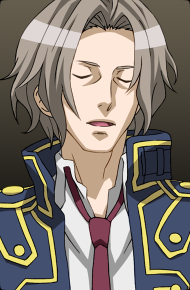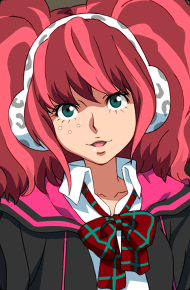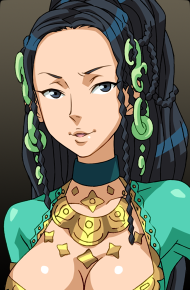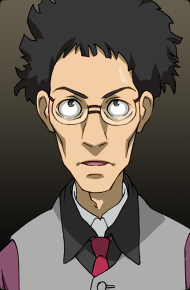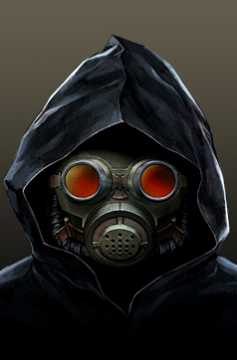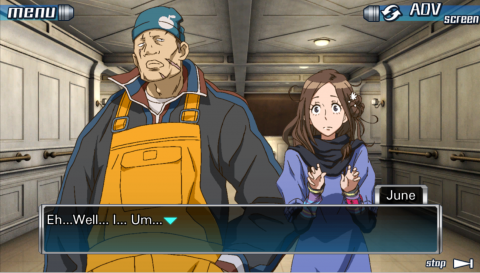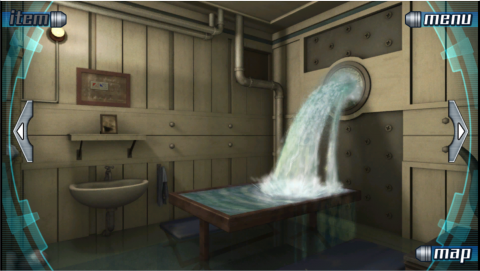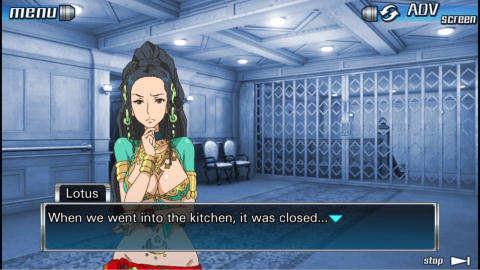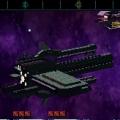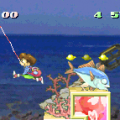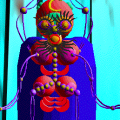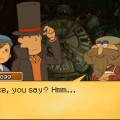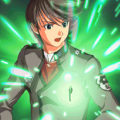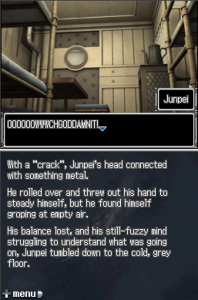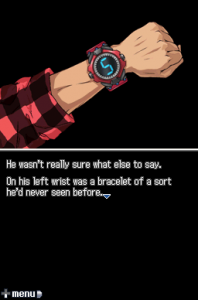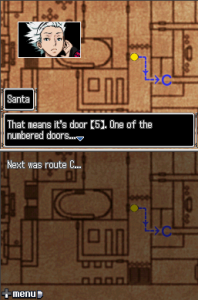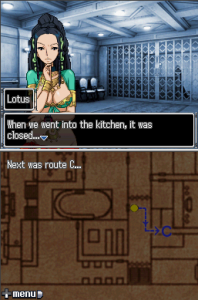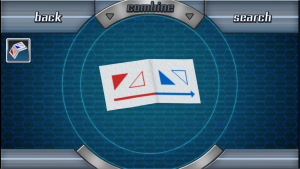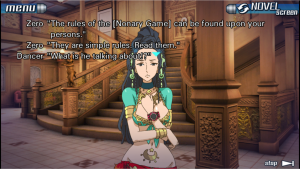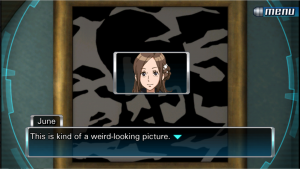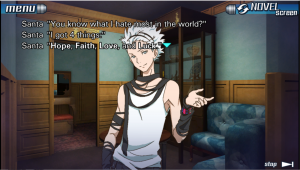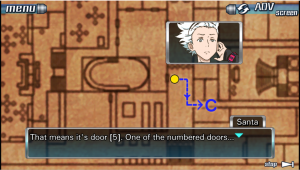- 999: Nine Hours, Nine Persons, Nine Doors
- Virtue’s Last Reward
- Zero Time Dilemma
999: Nine Hours, Nine Persons, Nine Doors is a Japanese adventure game directed by Kotaro Uchikoshi and developed by Chunsoft for the Nintendo DS, released in 2009 in Japan and in 2010 in North America. Although not particularly successful in Japan, it was one of the DS games that contributed to making this style of Japanese adventure games popular in the West in the early 2010s. It attracted a cult following in the US (it was never released in Europe), which helped spawn a trilogy, the Zero Escape games.
The premise of 999 is that nine people are kidnapped to play “The Nonary Game”, a potentially deadly escape game; depending on the number (1 to 9) they have been assigned to, they must go through numbered doors, which trigger point-and-click “escape the room”-style gameplay sequences. If you know the genre, you know what to expect: interpersonal tensions, tragic and gruesome deaths, plot twists, and multiple endings. But on top of its very nice presentation, this game is a particularly smart and well-constructed example of this kind of narrative, making it a must-read for fans of the genre. This style of narrative has roots in the earlier Infinity series of visual novels, also written by Kotaro Uchikoshi, but outside of a small release of Ever17 on the PC, none of these games had received English translations, which is probably one of the reasons why 999 resonated so strongly with international audiences.
Characters
Junpei
Our main protagonist, a college student kidnapped in his car on a dark night. He is brave, inquisitive, and resourceful. He doesn’t get to pick a nickname, as June blurts his real name in front of everyone.
June
A caring young woman, she is Junpei’s childhood best friend, although they had lost contact until then. They may or may not have feelings for each other; in any case, Junpei feels very protective of her. Her real name is Akane Kurashiki.
Ace
Taller and older than the other characters, the man is often calm and collected even in high-stress situations.
Snake
A graceful young man with a refined attitude and posture, he also happens to be blind.
Clover
Snake’s little sister, she is younger and can be impulsive and prone to big emotions.
Santa
A bit of a brat who likes to act cocky, his facade actually conceals a caring but jaded kid.
Seven
A big man with rather soft manners. Claims he has amnesia following Zero’s capture, which is either unlucky or convenient.
Lotus
An older woman who was on her way to belly-dancing class before her capture. Cunning, and will put her survival above the group’s.
The 9th Man
Very nervous and panicked, he is never given a nickname.
Zero
The mysterious figure is responsible for organizing the whole trap and kidnapped every player, who each remember seeing the cloaked figure with a gas mask before passing out.
Most of the game is spent in narrative sections, using the dual-screen to make it a hybrid between sound novels and visual novels: the top screen has character sprites talking in text boxes to the player, while the bottom shows an image (usually the location, but not always) with third-person narration showing Junpei’s internal thoughts and describing what is happening. The game is set on a massive sinking cruise ship, with some rooms (the ones you have to escape) having a different, often sinister concept. The locations are mostly pre-rendered 3D stills, which are clean and unobtrusive; while they look good, they are clearly not the focus of the game. The character sprites are very clean pixel art, and their poses are expressive and varied; the addition of animations, such as eyes blinking and some transition animations, make them feel very alive. The CGs show up in moments of tension, darkness, and threat, and are usually focused on the characters; while they look a bit more on the cartoony side, they are very effective and memorable. The game also incorporates some nice audiovisual gimmicks: the game’s intro is reminiscent of 2005-era TV shows (frantic drums, science-y overlays – think CSI or Re:Genesis intros), the start of escape room sequences are signaled with a very neat, trademark video clip, and doors opening trigger 3D animations that emphasize a successful escape.
Although the DS version has no voice acting, the game’s sound design is particularly good and instills much of the game’s oppressive atmosphere. The narration is punctuated by sound effects ranging from subtle to creepy, while the UI’s sound effects are intriguing electronic noises. Above all, the soundtrack (almost constantly present) is a highlight, setting a very fitting atmosphere that enhances the mood. The composer, Shinji Hosoe, describes it as “dark electronica”, and composed it to fit the game’s themes and atmosphere; there is often a strong electronic bass and sampled, hard percussions, some clipping and distortion effects, grating sounds, and reverberating, melancholic pianos. Some themes will be played dozens of times during the game, but they somehow do not get stale, and some are particularly memorable and effective.
The gameplay alternates between length narrative phases (one hour is not uncommon) and escape rooms, where you have to escape by solving puzzles. These provide a welcome change of pace and gameplay; in fact, there is a bonus one in one particularly long ending that is most certainly there to break it up in more manageable chunks. Each escape room has a theme, most of them sinister, and they mostly provide keys to open more doors, although some objects in the rooms will make some characters remember or talk about something that can prove important later. These rooms are mostly independent from the rest of the game; their design was subcontracted, although the game’s creator designed some puzzles and created the rooms’ themes. They aren’t particularly challenging, but are satisfying: no time limit, no red herrings, no pixel-perfect taps needed, just observing, gathering and combining objects, and sometimes solving classic puzzles, like a Sokoban or a magic square. You navigate the rooms across several screens in pre-rendered 3D, Myst-style, and tapping on the right area with the right object in hand will push the characters to do the obvious thing. The inventory screen allows you to combine objects, get other characters’ perspective on them (which can provide hints), and you can even rotate each object in 3D – although this is not utilized past the first room, which is a shame.
A major annoyance, however, is that the game makes you replay the escape rooms in all playthroughs. There is a good reason behind it: in most of these escape rooms, at least one important story chunk can be unlocked, by making or having made a choice earlier in the game. But because of this change in content, the puzzles are structured so you need to redo the whole process every time. This is grating, since the game has six different endings: a few bad endings, a good ending, and a true ending that goes beyond the good ending. However, even if you have to replay the escape rooms the second time around, the text you’ve already seen can be greatly sped up by holding down the right arrow. The game will take approximately eight hours the first time you play it; replaying it exactly the same way the second time around takes about an hour and a half, but the speed drops back to normal as soon as you make a different choice. Uncovering all the endings takes time, with the true ending itself being about five hours long after the last branching point, for a total of about 25 hours; the path to the true ending is not necessarily obvious, and the fact that you will have to replay the escape rooms makes it hard to recommend playing without a guide. Play one time with no guide, then use one of the several spoiler-free endings list to guide your subsequent playthroughs.
The game is driven by the interactions between the characters, and while the cast is rather large, the game does a very nice job making them all memorable. The nine characters were all kidnapped by a shadowy figure, Zero, who put them together on a sinking ship; they do not know each other, and end up using code names related to the number that Zero assigned them: Ace, Snake, Santa, Clover, June, Seven, Lotus, while Junpei, the titular character, uses his real name since it is blurted out. Uchikoshi mentioned using stereotypes that would be familiar to adventure game aficionados, and subverting them to make the characters interesting and engaging. It ends up working quite nicely: this well-rounded cast shows some depth, and as you get to know them and as their interactions move the plot forward, there isn’t really one that is less engaging than the others.
Unfortunately, the writing style itself is not the best, and not because of the quality of the translation. While some reviewers mention odd similes and clichéd sentences, the main problem is that the prose feels sometimes overly long. The dialogue and banter between characters is mostly fine, although some jokes do not land at all; however, the game goes out of its way to show every character reacting to every event. As for the third-person narration, it really does feel padded at times, with sentences that repeatedly describe the same thing in multiple equivalent ways over several screens, and actions broken down to all of their subcomponents. As for the themes, the game discusses scientific experiments, and blends real elements with fiction, in a way that initially makes you wonder if it is true (it sounds like something you might read about on Atlas Obscura). As you uncover more, these scientific aspects become supernatural, which may prove to be annoying.
But what really shines in 999, and elevates the game to a must-play, is its narrative construction. The game’s writing is extremely good at revealing precisely the right information, in the right amounts, in the right order, and at the right time – although it does tend to overuse the “character interrupts with an emergency!” conceit. The script is intricate, and have several layers of mystery that are uncovered progressively while avoiding resolving other ones; the twists are numerous, and will leave you guessing. At the core of the game’s construction is the “digital root” mechanism, a mathematical concept introduced 10 minutes into the game that is easy to understand and underpins the whole game. It is very rigorously applied, allowing characters to discard plans and hypotheses purely based on the numbers determining which groups of people can go through the numbered doors; the doors’ layout and each character’s number have been engineered by the developers (using an Excel spreadsheet) to maximize drama, and even hides a twist that is only revealed two hours before the final ending is reached. It is a marvel of a mechanism, understandable in 30 seconds yet powerful enough for the game to constantly go back to it from a different angle and create drama out of it; it is impressive and gives 999 a big part of its intricacy and complexity.
As you progress through the endings, the game is never short on twists, and pieces from every part of the narrative start making sense, revealing how complex 999‘s story is. It is actually a bit too complex for its own good: some parts of the narrative rely on well-worn tropes and things that are a bit far-fetched, and the answer to some questions is not very satisfactory. (Kotaro Uchikoshi did an AMA-style event a few years ago, answering 75 questions from fans; sometimes it feels like his justifications dig an even deeper hole.) However, there is no denying that all these moving parts work towards a genuinely smart and thrilling final twist, one that recasts the whole game in a different light and yet doesn’t feel too big, as the game has worked very carefully up to there to lay the pieces that allow you to instantly understand what is going on. Even though some of the individual pieces are a bit wobbly, the overall structure is wonderful and worth the trip.
An iOS adaptation of the game was released in 2013. 999: The Novel has the same narrative, with a few differences in its presentation, like text appearing in speech bubbles. It also adds a seventh ending, as well as a new interface showing the different branches of the game and allowing the player to jump to a different point of the story, which saves time when trying to see all endings. Most importantly, it removes the escape-the-room gameplay – the story points usually triggered during these rooms are stitched together by sentences explaining how the characters resolve the puzzles. Reviews were mixed, possibly because this removed the change of pace that the rooms brought to the game. The game is no longer available on the Apple Store, but a couple of video walkthroughs exist, and fan wikis list the differences between the versions.
The game was re-released in 2017 on Windows, PS4, and PS Vita, as a mostly straight port/remaster of the original game, and, as such, does not feature the seventh ending from the iOS version. The interface changed to two switchable modes: in the “novel screen” mode, the third-person narration and the dialogue are both displayed on top of the graphics and characters, as in a sound novel; in “ADV screen” mode, only the characters’ lines are displayed in a classic VN-style text box. The location graphics have been redone, as well as the objects in the escape rooms. The character portraits are actually the artists’ high-res original drawings, meaning there is no difference with the original game; however, they do look noticeably more “drawn-in” and two-dimensional, which is distracting. The game also features voice acting, both in Japanese and English; both dubs are of very good quality, but the Japanese dub is slightly better, as the English dub has a very dry mix and at times slightly exaggerated acting that can break the illusion. Other nitpicks include the auto-skip, noticeably slower than on the DS, and the game’s tendency, on some computers, to freeze when loading assets and lines of dialogue. Finally, the game features a flow chart very similar to the one present in the iOS version, which saves time when playing to see several endings; just make sure you understand how unlocking some of the parts of the flowchart works.
Screenshot Comparisons

